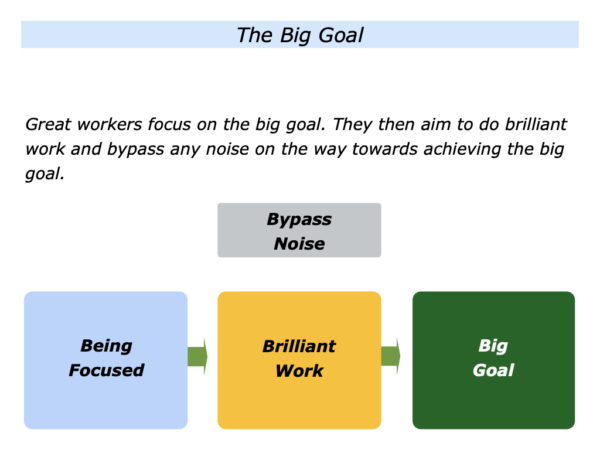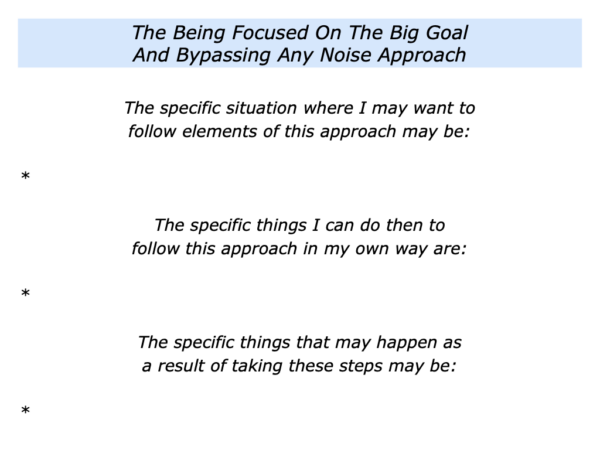
There are many ways to do fine work. One approach is to continually focus on the big goal. It is then to aim to do brilliant work and bypass any noise on the way towards achieving the big goal.
Great workers often follow this approach. Let’s explore how they translate this into action.
They Focus On The Big Goal
Good leaders, for example, start by clarifying the goal they want to their team to achieve. Different leaders do this in different ways. Let’s look at some examples.
They may focus on a purpose and translate
this into working to achieve a specific big goal
They may aim to ensure that every child has enough to eat, find a cure for a particular illness, build a country that achieves net-zero or achieve another purpose. They translate this into working to achieve a big goal.
They may focus on a principle and translate
this into working to achieve a specific big goal
They may aim to care for people, provide superb medical treatment, help their clients to succeed or follow another principle. They then translate this into working to achieve a big goal.
They may focus on a picture of success and
translate this into working to achieve a specific big goal
They may aim to help people to achieve a peace in their country, send people to the moon and return them safely or achieve another picture of success. They then translate this into working to achieve this big goal.
Great leaders, for example, then communicate the big goal to their people. Different people will do this in different ways. Some use elements of the following framework.
The Big Goal
The Goal. The big goal we want to achieve –
together with some examples to bring this to life – is:
* To …
For example, we want:
* To …
* To …
* To
The Strategies. The strategies we want to follow to do our best
to achieve this goal – together with the reasons for these – are:
* To …
* To …
* To …
The Benefits. the benefits of achieving this
goal – for the various stakeholders – will be:
* To …
* To …
* To …
The Roles. The roles of various people in working to achieve
the goal – and the support we will give them – will be:
* To …
* To …
* To …
The Measures. The specific things that will be happening
that will show we have achieved the goal will be:
*
*
*
Imagine that a leader has communicated the big goal to their people also given them the big picture. It can then be time to move on to the next step.
They Do Brilliant Work
Different people take different approaches to doing brilliant work. People who work as individuals may focus on doing the basics and then adding the brilliance on the way towards achieving their big goal.
Good leaders encourage their people to focus on similar themes. They may take the following steps, however, to encourage their people to do brilliant work.
They keep communicating the team’s goal, the strategies to follow and the benefits of achieving the big goal;
They make clear contracts with people about their contributions to achieving the big goal;
They encourage people to keep doing the basics and deliver consistently high standards on the way towards achieving the big goal;
They manage by outcomes and give people the support they need on the way towards achieving the big goal;
They keep publishing success stories that show how people are doing superb work on the way towards achieving the big goal.
Good leaders share these success stories to show what good looks like. They then encourage people to keep doing these basics and, when appropriate, add the brilliance on the way towards achieving the picture of success.
Different workers have different ways of doing brilliant work. Some also take the following step on the way towards achieving their aims.
They Bypass Any Noise On The Way
Towards Achieving The Big Goal
Great workers continue to focus on doing good work every day. They also learn to bypass any irrelevant noise that could be distracting.
Some people take the following steps. They aim: a) to focus on what they can control; b) to cocoon themselves; c) to keep doing creative work on the ways towards achieving the big goal.
An artist may cocoon themselves by focusing on the things that give them positive energy. They also cut themselves off from negative things that are happening in the world.
A golfer may cocoon themselves by following a positive mantra and aiming to produce their best performance. They may cut themselves off from any negative scripts or crowd noise.
A good leader may protect their team by managing upwards and providing air cover. This can be necessary if there is interference from other people in the organisation.
Such a leader recognises that sometimes outside events mean that the team needs to be agile. It may then be necessary to change or develop the big goal.
The leader will protect their team, however, if it gets conflicting messages from the top or is distracted by unreasonable requests from other departments. The leader will then meet with the key stakeholders:
To clarify that the organisation still wants the team to work towards the big goal;
To make sure the team is given the support and space they need to achieve the big goal.
Great workers bypass any unnecessary noise on the way towards achieving their aims. They continually do reality checks, however, and are prepared to learn from people they respect.
They then focus on continuous improvement. They gather information and data about: a) the things they are doing well; b) the things they can do better. They then implement these idea to keep improving.
There are many ways to do fine work. One approach is to focus on the big goal. It is then to do brilliant work and bypass any noise on the way towards achieving the big goal.
Let’s return to your own life and work. Looking ahead, can you think of a situation where you may want to follow elements of this approach? How can you do this in your own way?
If you with, try tackling the exercise on this theme. This invites you to complete the following sentences.







Leave a Reply